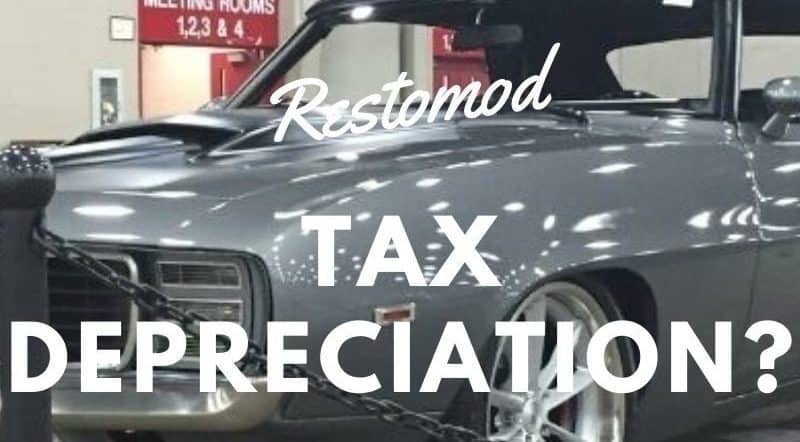After countless hours studying classic car restomod tax deductions, I’m ready to provide some information on this little-known topic. To write this article, I have reviewed more than 50 articles, and spent more time on the IRS website, and spoken with accountants, than I ever thought possible.
Can You Deduct A Restomod?
Let’s get right to it. Yes, there are specific scenarios where you can deduct a restomod. We’ll look at deducting a restomod from the perspective of being self-employed, a small business owner, and being employed by someone else.
Self-employed
If you are a self-employed individual or a sole proprietor, you can deduct the cost of business use even if it’s on your personal vehicle. This is the best method for those who work under a sole proprietorship rather than as a legal business structure such as a corporation. The key here is to separate business use from personal use.
Key definitions to understand relative to being self-employed:
- Self-Employed Definition. According to the IRS, a self-employed individual earns money on a per-job or per-task basis, usually for short-term work. A self-employed individual is not an employee of a firm, and may, therefore, be at liberty to complete different jobs concurrently by various individuals or firms, unless contractually specified to work exclusively until a particular project is completed.
- Sole Proprietorship Definition. A sole proprietorship also referred to as a sole trader or a proprietor, is an unincorporated business that has just one owner who pays personal income tax on profits earned from the business.
Small Business Fleet Deductions

If you’re running a small business, a vehicle used exclusively for business can add to your yearly tax deductions as part of your operating expenses. While the cost of overhauling (read “improving) a business vehicle doesn’t qualify as a deduction (overhauling must be included in capitalization cost and calculated in the depreciation cost), the cost of repair can be deducted.
Key definitions to understand relative to small business fleet deductions:
- Operating Expenses are expenses businesses incur through their normal business operations. Often abbreviated as OPEX, operating expenses include rent, equipment, inventory costs, marketing, payroll, insurance, and funds allocated for research and development.
- Capitalization is an accounting method in which a cost is included in the value of an asset and expensed over the useful life of that asset, rather than being expensed in the period the cost was originally incurred.
- The useful life of an asset, this case restomod, is an accounting estimate of the number of years it is likely to remain in service for the purpose of cost-effective revenue generation.
- The useful life of an asset, this case restomod, is an accounting estimate of the number of years it is likely to remain in service for the purpose of cost-effective revenue generation.
- Depreciation is an accounting method of allocating the cost of a tangible or physical asset over its useful life or life expectancy. Depreciation represents how much of an asset’s value has been used up. Depreciating assets helps companies earn revenue from an asset while expensing a portion of its cost each year the asset is in use. If not taken into account, it can greatly affect profits.
Keep clear records of repairs, because just claiming an estimated cost won’t go over well with the IRS.
Unreimbursed business expenses
If you’re employed by a company and have used your own personal vehicle for business-related purposes, you can claim those expenses on your tax deduction if your company has not reimbursed you. These expenses could include fuel costs and maintenance and are usually best calculated by using a per-mile cost, which the IRS updates on a regular basis.
As with self-employed tax deductions, the key is to keep clear records and differentiate between business use and personal use.
The Bottom Line
Unless you’re using your car exclusively for your business, you can’t deduct the full cost of purchasing, maintaining, and repairing it. You can and should, however, deduct what you can. The key is, AND I CAN’T STRESS THIS ENOUGH, as with almost any issue to do with the IRS, is having clear records to support your claims.
Are Restomod Repairs Tax-Deductible?

Yes, car repairs are deductible if you use your restomod for business however, there are certainly some rules that apply.
When they are deductible
The actual expense method allows you to write off many costs. This includes business driving costs, car repairs, and car improvements. You add these costs to your other annual expenses.
If you use the standard mileage rate, you get no deduction for repairs. These are already factored into the standard rate.
With the actual expense method, you may only deduct your business use percentage of your car repairs and improvements. If you drive your car 50% of the time for business, you can deduct 50% of the cost
If you drive your car 50 percent of the time for business, you can deduct 50 percent of the repair costs. The remaining costs is a nondeductible personal expenses. You may deduct the cost of parts and depreciate the cost of tools if you fix the car yourself. But, there’s no deduction for your labor.
Many of the expenses you incur to keep your car running are currently deductible—that is, the full amount can be deducted in the year incurred. Yet, some must be depreciated over at least five years. It all depends on whether the expense is for:
- A repair
- An improvement
Standard Mileage
The 2020 standard mileage rates are as follows:
- 57.5 cents per mile for business (which is a decrease from 2019)
- 17 cents per mile for medical (which was 20 cents in 2019)
- 14 cents per mile for charity (which is no different than 2019)
Standard mileage rates for 2020, 2019, and prior years?
| Year | Rate Per Mile | Dates |
| 2020 | 57.5 cents | 01/01/2020-12/31/2020 |
| 2019 | 58 cents | 01/01/2019-12/31/2019 |
| 2018 | 54.5 cents | 01/01/2018-12/31/2018 |
| 2017 | 53.5 cents | 01/01/2017-12/31/2017 |
| 2016 | 54 cents | 01/01/2016-12/31/2016 |
| 2015 | 57.5 cents | 01/01/2015-12/31/2015 |
| 2014 | 57.5 cents | 01/01/2014-12/31/2014 |
| 2013 | 56 cents | 01/01/2013-12/31/2013 |
| 2012 | 56 cents | 01/01/2012-12/31/2012 |
| 2011 | 55.5 cents | 01/01/2011-12/31/2011 |
| 2010 | 51 cents | 01/01/2010-12/31/2010 |
How to calculate mileage for taxes

You can claim mileage on your tax return if you kept diligent track of your drives throughout the year. In 2020, you can write off 57.5 cents for every business mile. You have two options for deducting your vehicle expenses: the standard mileage rate or the actual expense method.
With the standard mileage rate, you take the deduction of a specified number of cents for every business mile you drive. Multiply your business miles by that year’s standard mileage rate for your deduction
Example: Ed, an independent salesperson, drove his car 20,000 miles for business in 2019. To determine his mileage deduction, he should:
- Gather the total number of business miles for the year
- Multiply that by the standard mileage rate for 2019
- Come to a mileage deduction of $10,900 for the year (58 cents × 20,000 = $11,600)
What does the IRS consider a business drive?
With the mileage deduction, the IRS only lets you deduct trips that are for business. Here are the drives the IRS considers to be business:
- You can take the mileage deduction write-off for travel from your office or worksite to the second place of business
- Driving for business-related errands qualifies as a business drive. This can include going to the bank, office supply store or post office. These small trips add up quickly, and many business owners forget to keep track of these drives
- Business meals and entertainment
Trips you make to meet with clients or vendors qualify for this deduction. This can include drives for dinner, coffee, drinks, etc - The miles you drive to and from the airport for a business trip qualify for mileage deduction
- Drives to and from odd job locations can be written off. These can include side-gigs like babysitting, pet care, lawn work, and more
- Driving from your office or another worksite to meet with customers or clients for business qualifies
- Temporary job sites
- Driving from home to a temporary work location that you expect to last (and does, in fact, last) less than one year
Actual Expenses
The Actual Expenses method is based on the expenses you actually incur in the operation of your vehicle. It includes things like:
- gas purchases
- oil changes
- tire purchases
- car washes
- insurance
- vehicle depreciation
However, you can only claim the percentage of expenses that apply to the business use of your vehicle. To compute this, you must know how many miles you drove for business purposes and how much you drove for personal reasons.
To find the percentage of your car’s use for business, divide your total business miles by the total number of miles you drove for the year (business + personal).
- For example, if your Annual Summary shows that you drove 5,000 online miles and your odometer indicates you drove 10,000 miles for the year, divide 5,000 by 10,000.
- The result is 0.5, or 50%. This is the percentage of your vehicle’s business use.
You then multiply the total of your actual expenses by this percentage to arrive at your actual expenses deduction.
- For example, if your actual expenses were $9,500, you would multiply that figure by 50 percent.
- Your deduction would be $4,750 ($9,500 x .50 = $4,750).
The deduction is large because the actual expenses are large. In the example above, the actual expenses include:
- $1,000 gas
- $1,500 insurance
- $6,000 lease payments
- $400 repairs
- $100 oil
- $500 car washes
Can you deduct mileage to and from work?
Generally, you cannot deduct mileage to and from work. The IRS defines the first trip from your house and the last drive back as a non-deductible commute. This is true even if your commute is far. The IRS considers where you live a personal choice and, thus, a personal expense.
Working during a commuting trip is still considered commuting. This includes making business calls, listening to work-related tapes or having business discussions.
How to get around the IRS commuting rule with a home office
One way to avoid the harsh commuting rule is to have a qualifying home office. With this, you can take a mileage deduction for any trips you make from your home office to another business location. Make sure you’re following the rules about a home office, though.
Home office tax deduction for small businesses
The home office deduction can save you taxes. It allows you to deduct a part of your rent or mortgage payments, utilities, and other home expenses. It can also increase your business mileage deduction.
Here’s what to know about the home office tax deductions for small businesses and self-employed.
Home office deduction checklist

We’ll dive into the specifics of the home office tax deduction below. The key takeaways you should know are:
- You must use your home office only for business
- It only applies to the self-employed now
- There are two methods to calculate the write-off for business use of home
- A qualifying home office can lead to larger overall driving deductions
How do you calculate a home office deduction?
If your home office is 300 square feet or less, the IRS has an optional simplified method of calculating your home office deduction. You can deduct $5 for every square foot of your home office up to a maximum of $1,500. For example, if your home office is 200 square feet, you’ll get a $1,000 deduction.
Here’s a quick comparison of the two methods for taking a home office deduction:
| Criteria | Traditional Method | Simplified Method |
| Amount of space | Percentage of your home used for business | Cannot exceed 300 square feet |
| Amount of Deduction | Actual costs associated with home office | $5 per square foot |
| How to Deduct | Home-related itemized deductions apportioned between Schedule A and business schedule (Sch. C or Sch. F) | Home-related itemized deductions claimed in full on Schedule A |
| Depreciation Deduction? | Applied to portion of home used for business purposes | No depreciation deduction |
| Can Deduction Exceed Gross Income? | No, deduction cannot exceed gross income from business use of home minus business expenses | Same |
| Can Excess of Gross Income Limitation Be Carried over? | Yes | No |
| Requires Documentation? | Yes | Yes |
What is the business use of the home?
A home office is a place in your home that is used exclusively for business purposes. The IRS offers taxpayers a home office deduction to offset a portion of the costs of their home offices.
The home office deduction allows independent contractors, small business owners, and others to lower their taxable income. In general, it’s meant for independent contractors but there are circumstances where W2 workers can take this write-off.
What are the home office requirements for tax purposes?
To qualify for this deduction, you must meet three threshold requirements:
- You must be in business
- You must use part of your home only for business (unless you store inventory at home or run a daycare center)
- Use the home office for business on a regular basis
You must meet all three threshold requirements. You must also meet any one of the following requirements:
- The home office is your principal place of business
- You regularly and exclusively use your home office for business activities. This could include managerial or administrative work
- You meet clients or customers at home
- A separate structure on your property only for business purposes is used
- Storing inventory or product samples at home
- You run a daycare center at home
Tax write-off for home office rule #1: You must be in business
You must be in business to take this deduction. You can’t get the write-off for a hobby or other nonbusiness activity that you conduct out of your home. Yet, you don’t have to work full-time in a business to qualify for this. If you meet the requirements, you can take the deduction for a side business.
If you’re an employee in someone else’s business, you can qualify for this. But, this is only if the home office is for the convenience of the employer.
Business use of home rule #2: You must use your home office only for business
You can only take this deduction if you use part of your home only for your business. If your home office is also used for personal reasons, you won’t qualify for the deduction. The more space you devote only to your business, the more your deduction will be worth.
Home office expense deduction rule #3: You must use it regularly
It’s not enough to use a part of your home only for business—you must also use it regularly. You can’t place a desk in a corner of a room and claim this deduction if you almost never use the desk for your business.
How much is “regularly?” It’s not clear. The IRS only says you must use your home office for business on a continuing basis. One court has held that 12 hours of use a week is enough.
There is a good chance that you could also qualify with less use but no one knows for sure. You can keep track of how much you use your home office by making simple notations on a calendar.
One more rule for a home office tax deduction
You also must meet at least one of the following requirements to qualify for this deduction.
- Your home is your principal place of business
- You do administrative work at home
- You meet clients or customers at home
- Use a separate structure for business
Can employees deduct their home office?
No. Tax reform removes the ability to claim miscellaneous itemized deductions, including the home office deduction.
How much is the standard home office tax deduction?
The amount saved will depend on your costs. But, the home office tax deduction often provides significant tax savings because you may be able to include a portion of your mortgage or rent. Also, a home office deduction may unlock other deductions like an increased mileage deduction.
Regular method: Tax write-off for home office
The traditional method includes the actual expenses you incur for your home. Such expenses fall into two broad categories: direct and indirect. Direct expenses are what you incur just for your home office.
This can include costs like painting your home office or paying someone to clean it. The entire amount of a direct home office expense is deductible.
An indirect expense is a payment for something that benefits your entire home. Most of your home office expenses will be indirect expenses, including:
- Rent, if you rent your home or apartment
- Mortgage interest and property taxes if you own your home
- Depreciation, if you own your home
- Utilities
- Insurance
- Home maintenance expenses for your entire home
You can only deduct part of an indirect expense: the percentage which relates to your home office. For example, let’s say you’re a renter and use 20 percent of your home for your home office. You’ll be able to deduct 20 percent of your rent, utilities, and other indirect expenses.
Simplified home office deduction
The IRS has created an optional simplified method of calculating your home office deduction. You deduct $5 for every square foot of your home office. Thus, all you need to do is measure the square footage of your home office.
For example, if your home office is 200 square feet, you’ll get a $1,000 deduction. That’s all there is to it. You can only use this method if your home office is 300 square feet or less.
Get the biggest tax write-off for your home office
In order to get the largest home office deduction, you’ll likely have to use both methods to find which deduction is larger. Remember, your deduction can’t exceed the gross income from the business use of your home.
In general, deducting the actual expenses will get you a larger write-off. This is especially so if you’re living in an area with high mortgages or rent. Don’t forget to keep track of all your house expenses to back up this deduction.
How the home office tax deduction can increase your mileage deduction
If you drive for your business, using the home office deduction can increase your mileage deduction. This is because it can cut out the IRS’s commuting rule. The IRS says that personal commuting is not deductible. For example, you can’t deduct the cost of driving from home to your regular outside office.
For professionals like Uber drivers, this can sting. The IRS commuting rule prevents you from writing off the cost of driving from home to pick up your first ride. This same rule applies to the drive home from your last ride.
That changes if you have a qualifying home office. Your home office qualifies as your principal place of business if:
- It’s the place where you earn most of your income
- It’s where you perform most of your administrative or business management tasks
You can increase your deductions for business trips with a qualifying home office. For example, you can deduct driving from home to an outside office. You can also deduct driving from home to pick up a passenger if you’re an Uber or Lyft driver.
Can you deduct internet costs if you work from home?
You may deduct a portion or all of your internet expenses. You can only deduct it if you use the internet specifically for work purposes. Many of you likely use it for business and personal reasons, though.
If you use the actual expense method for your home office deduction, you can deduct the portion you use for work. If you use the internet at home 20 percent of the time for business, deduct 20 percent of your costs.
Tax Deductible Restomod Repairs
A repair doesn’t make the vehicle better than it was in the past. In other words, a repair doesn’t rise to the level of improvement described below. Repairs generally consist of minor fix-ups. One example is fixing a tail light.
Car repairs are currently deductible in full the year they’re made. A repair keeps your vehicle in an efficient operating condition. Routine car maintenance is also currently deductible. For example, changing the oil, replacing air filters, and installing new windshield wipers.
How to claim mileage on taxes
If you’re using the standard mileage rate, first calculate the value of your deduction. You can also add your business parking costs and toll expenses. You’ll also need to tally up your total commute miles and personal (non-commute) miles for the year.
When you’re filling out your Schedule C, you can input your mileage deduction on Line 9. Put your mileage totals on Part IV, Line 44. The IRS will also want to know your starting odometer reading, your commuting miles, and your personal, non-commuting miles. If you’re a W2 employee, there are scenarios where you can still write off business miles. You can learn more about that in this article about mileage reimbursements.
Mileage reimbursement versus mileage deduction
It’s important to note the difference between mileage reimbursement and mileage deduction. A reimbursement is when an employer or client pays you a specific rate for the miles you drive. Mileage deduction is when you take a write-off for the miles you drove on your annual tax return.
The IRS doesn’t require employers or clients to reimburse you for mileage. Many do to maintain and attract workers, but there’s no mandated federal mileage rate for non-governmental employees.
How many miles can you claim on your taxes?
There is no limit to the miles you can claim on your taxes; you can claim as many miles as you can substantiate. With that said, some claims raise a red flag with the IRS, including:
- Having a round number like 25,000 miles
- Claiming 100 percent of your miles for business
- Claiming an unusually high number of miles
Can I claim tolls to work on my taxes?
Yes, you can deduct business-related parking and toll costs from your taxes. Just make sure you keep compliant records.
Can you claim car insurance and other vehicle expenses on taxes?
The standard mileage rate includes a lot of the costs related to your vehicle, but it doesn’t cover all expenses. If you use the standard mileage rate, you can deduct the following vehicle-related expenses:
- Interest on a car loan
- Parking fees and tolls for business
- The personal property tax you paid when you bought the vehicle, based on its value
How to track mileage for taxes
The huge advantage of the standard mileage rate is that it requires less record keeping. You do need to keep track of:
- How many miles do you drive for business
- The total miles you drive
Yet, keeping an accurate mileage log can be tedious. The IRS requires those logs to be reasonably detailed. You can also use a mileage tracking app like MileIQ to make the process easy and ensure you’re in compliance.
Restrictions on the standard mileage rate deduction
There are some important restrictions on who can use the standard mileage rate. If you don’t qualify to use it, you must use the more complicated actual expense method.
You must use the standard mileage rate the first year you use a car for business. If you fail to do so, you are forever stuck using that method for that car. You can switch between the modes but only if you use the standard mileage rate the first year.
It’s a good idea to use the standard mileage rate the first year you use the car for business.
If you choose the standard mileage rate method, you cannot deduct actual car operating expenses. All of these items, as well as depreciation, are factored into the standard mileage rate set by the IRS.
However, you can deduct interest paid on a car loan, as well as parking fees and tolls for business trips. You can’t deduct parking ticket fines or the cost of parking your car at your place of work.
Tax-deductible restomod improvements
Unlike repairs, improvements to your business vehicle are not currently deductible business expenses. Instead, you must depreciate these costs over at least five years, often longer.
How do you tell the difference between a repair and an improvement? It can be difficult. An expense is for an improvement if it:
- Materially adds to the value of the property involved
- Adapts the property to new or different use, or
- Substantially prolongs its useful life
IRS regulations provide that improvements include:
- Curing a “material condition or defect” in a vehicle that existed before it was acquired or when it was produced
- A “material addition” to a vehicle—for example, physically enlarging or expanding it
- A material increase in a vehicle’s capacity, productivity, strength, or quality
- Replacing a major component or part
- Rebuilding a vehicle to like-new condition after it has fallen into disrepair
- Rebuilding a vehicle to like-new condition after you’ve used it in your business for over five years
The same rules apply to depreciate improvements as for regular auto depreciation. Depreciation of the original automobile and the later improvements are combined for purposes of the annual depreciation limits.
Under these limits, for example, you can only depreciate a total of $3,160 for a passenger automobile placed in service in your business in 2014. This includes the original car and any improvement you make that year. Because of the annual depreciation limits, it can take many years to fully depreciate a passenger automobile.
Old Laws Harmed Restomod Deduction
In 1981, lawmakers simplified depreciation deductions and removed the requirements of “salvage value” and “estimated useful life,” both of which could have prevented your write-off of the restomod.
New Laws Benefit Restomod Deduction
As a result of the 1981 changes, both Brian P. Liddle and Richard Simon won tax deductions for rapidly appreciating almost 300-year-old rare violins and violin bows coveted by collectors. The courts noted that although the violins and bows would not have been depreciable under pre-1981 law, depreciation simplification in the 1981 law enabled the deductions for antique violins and bows that were used by musicians.
Where Does The IRS Stand
In its Action on Decision 1996-009, the IRS said that it will not follow the Liddle and Simon cases and that it expects to bring a case in a different circuit. The IRS wants to create a different result so it can appeal antique depreciation to the Supreme Court in the hopes that the court will rule that antiques are no longer deductible.
I have to point out that for the past 23 years, the IRS has not yet found a conflicting case to bring to trial, much less one that might produce a result different from Liddle and Simon.
What Is “Recovery property” and Why Does It Matter?
The taxpayers in Liddle and Simon won their cases based on a 1981 law that created the term “recovery property” as a replacement for the term “depreciation.” A 1986 law deleted the term “recovery property” from Section 168 depreciation, but as the court noted in Selig, that change did nothing to impact the favorable results given antique depreciation in Liddle and Simon.
In Selig, a court case that involved post-1986 law and that triggered the IRS Action on Decision, the court stated that it would follow Liddle and Simon. As a result, if Selig could show that the exotic automobiles he desired to depreciate were subject to exhaustion, wear, and tear, or obsolescence, he could then depreciate them.
How does the IRS handle it?
The IRS does not like to bring a case to court that it will lose. Further, should the IRS bring a case where its position is “not substantially justified,” then you can collect attorney fees and court costs from the IRS if your net worth is less than $2 million? If the IRS has lost in courts of appeal on substantially similar issues, then the IRS is automatically presumed to be “not substantially justified” and you win attorney fees and court costs.
You have a big shield to protect you thanks to the Liddle and Simon victories. It’s highly likely that you would win attorney fees and court costs should the IRS attack your 1972 GTO tax deductions. And what this really means is that the IRS is not looking for a fight with you on your restomod tax deductions, because it has little chance of winning.
Is A Restomod A Good Investment?
Thank the Tax Cuts and Jobs Act (TCJA) for making the money equation easy. Under the TCJA, you encounter no depreciation differences between a 2019 Lexus GS and the restomod. That’s because the TCJA uses the same depreciation schedule for both new and used cars. Of course, we expect that you will incur more repairs and higher operating costs with the restomod than with the 2019 Lexus GS.
But after, say, five years of use, you should be able to sell the restomod for much more than you could sell the Lexus, which will decline to about 40 percent or so of the $50,000 you would pay for it.
The Tax Cuts and Jobs Act (TCJA) has plenty of good news for small businesses and their owners, including super-favorable first-year depreciation breaks for vehicles used for business. These breaks have not gotten much attention. But if you read this, you’ll know what you need to know.
Bigger depreciation allowances for passenger vehicles
For both new and used passenger vehicles that are acquired and placed in service after 12/31/17 and used over 50% for business, the TCJA dramatically and permanently increases the so-called luxury auto depreciation allowances. For vehicles placed in service (put to business use) in 2018, the maximum allowances are:
- $10,000 for Year 1 or $18,000 if you claim first-year bonus deprecation (see below).
- $16,000 for Year 2
- $9,600 for Year 3
- $5,760 for Year 4 and thereafter until the vehicle is fully depreciated
If you don’t use the vehicle 100% for business, these allowances are cut back proportionately. These allowances will be indexed for inflation for 2019 and beyond.
Additional first-year bonus depreciation for passenger vehicles
If you claim first-year bonus depreciation for a new or used passenger vehicle that is acquired and placed in service between 9/28/17 and 12/31/26, the TCJA increases the maximum first-year luxury auto depreciation allowance by $8,000 (from $10,000 to $18,000 for 2018).
However, a used vehicle cannot have been previously used by you or your business entity; it must be new to you or the entity. The $8,000 bump for bonus depreciation is scheduled to disappear after 2026, unless Congress takes further action. Under prior law, used vehicles were ineligible for first-year bonus depreciation.
Prior-law allowances for passenger vehicles were skimpier
For 2017, the prior-law allowances for passenger vehicles were $11,160 for Year 1 for a new car with additional first-year bonus depreciation or $3,160 for a used car, $5,100 for Year 2, $3,050 for Year 3, and $1,875 for Year 4 and thereafter. Slightly higher limits are applied to light trucks and light vans. So the TCJA allowances are a big improvement.
100% first-year bonus depreciation is allowed for heavy SUVs, pickups, and vans used over 50% for business
The TCJA allows unlimited 100% first-year bonus depreciation for qualifying new and used assets that are acquired and placed in service between 9/28/17 and 12/31/22. However, a used asset cannot have been previously used by you or your business entity; it must be new to you or the entity. Under prior law, the first-year bonus depreciation rate for 2017 was only 50%, and the bonus depreciation was not allowed for used assets.
The new law’s 100% first-year bonus depreciation deal can have a hugely beneficial impact on first-year depreciation deductions for new and used heavy vehicles used over 50% in your business. That’s because heavy SUVs, pickups, and vans are treated for tax purposes as transportation equipment rather than passenger vehicles, and that means they qualify for 100% first-year bonus depreciation.
However, you must use a heavy vehicle over 50% for business for 100% first-year bonus depreciation to be available. Otherwise, you must depreciate the business-use percentage of the vehicle’s cost over a six-year period.
To deduct the classic or antique car:
- The car must be of a type that’s subject to wear and tear decay, decline, or exhaustion
- The car must be used in your trade or business.
Depreciation: Good or Bad?

A restomod is a classic car with lots of moving parts. On top of that, the car you are driving this year may be depending on a number of factors, have a newer and more improved model the following year. Essentially there are only a handful of cars that gain in value, and those are classic or collector cars. For most other people, your cars will depreciate, and that can have implications on your car insurance.
Depreciation Is an Important Factor When Your Car Is Totaled
When you “total” a car, it means that it would take more money to repair the car than what it is actually worth. Totaling your car is a big deal, as it means your insurance company will have to pay you the full amount of the value of your car (if you have collision insurance). The full amount they pay you though depends on how much your car has depreciated. When you total a car you are paid the ‘actual cash value’. So even if you bought your car for $50,000 three years ago, it is likely worth several thousand dollars less. As a driver and policyholder, you need to be aware that your insurance company will only pay you the actual cash value.
Our advice would be to keep track of the value of your car throughout your time of owning it. The actual cash value is determined by your company’s claims adjuster, but if you are keeping track of the value of your car, you may calculate the value differently. Insurance companies will always try to reduce how much they want to pay, so the claim adjuster’s actual cash value number is likely going to be conservative. If you feel the amount you are being offered is lower than your calculations you may negotiate.
Depreciation is a Reason You May Want to Consider Gap Insurance
When you lease or finance a car, your payments reflect the cost of the vehicle when it’s brand new. Due to depreciation, however, you end up paying more in the loan or lease payments that what the car is actually worth when you’re done with your payments. This is a problem if you total your car.
As we say above, if you total your car, your company will only pay you a fraction of what the car was worth when you first bought it. If you owe still several thousand dollars on your lease or loan, the amount you receive back from your company may not be enough to cover that amount.
This is called the ‘gap’. It’s the reason why we recommend if you lease or finance your car, you get gap insurance. Being ‘upside down’ on your car payments, as in, your car is worth less than what you owe, can end up costing you thousands of dollars while gap insurance can cost you less than $100 per year.
Classic Car Insurance and Depreciation
If you own a classic or collector car, the opposite of depreciation is what you actually have to worry about. When a car starts to gain in value as time goes on, the car is considered a collectible or a classic. Late 1960’s muscle cars are one example. You cannot insure a classic car with regular insurance because its value is going up, and thus your insurance would have to pay more than what you’ve paid them if it were totaled.
You would need classic car insurance. With classic car insurance, you take the actual cash value of the car at the time of getting your policy and that will be the amount your car will be insured for, for the duration of the policy. In a way, it is the opposite of the gap for leasing a car. Again though, you should keep careful track of the value of your car so you always know if an insurer is low balling you on the value of your car.
How Do I Sell A Deducted Restomod?

Whether you sell or trade-in a business vehicle can have a big impact on your taxes. Let’s dive into the options on what to do when it’s time to sell the car you use for work.
When to sell versus when to trade in a company car
As a general rule for a business vehicle:
- Sell the car if the sale results in a loss for tax purposes (as it usually does)
- Trade in the car instead of selling it if you’d earn a profit on the sale
Do you have to pay taxes when you sell a car?
First, you should determine whether you earn a profit or incur a loss on the sale of a business vehicle. Subtract the car’s adjusted basis from its sales price. The adjusted basis is the car’s original cost minus any depreciation deductions you’ve taken while you owned it.
If you use the actual expense method to deduct your business driving, you calculate and separately deduct your depreciation deduction each year. With the standard mileage rate, you get no separate deduction for depreciation because the standard rate includes it.
To determine how much depreciation you’ve taken, multiply the total business miles you drove the car by the amount of the standard mileage rate that accounts for devaluation. These amounts appear in a chart in IRS Publication 463, Travel, Entertainment, Gift, and Car Expenses.
Usually, a car is sold at a loss because its true resale value is less than the depreciation allowed by the IRS. A loss on the sale of a business vehicle is good tax-wise because you can deduct it from your other income. So you should sell your car instead of trading it in if the sales price is less than your adjusted basis.
Selling a business vehicle: A few exceptions
The above example assumes you use the car 100 percent for business. If you use it less than 100 percent, you may only deduct the business portion of your loss.
Subject to two exceptions, you can sell your old car to anyone and deduct the business portion of your loss. You may sell to a car dealer, but you cannot purchase another car from the dealer at the same time—this would be considered a trade-in by the IRS.
- Exception #1: You cannot sell your old car to a close relative and deduct your loss. For these purposes, a close relative is any lineal descendant or ancestor, such as parents, children, siblings, or grandparents.
- Exception #2: You cannot sell your car to a business entity, such as a corporation or LLC in which you are the majority owner, and deduct your loss. Thus, for example, you can’t form an LLC, sell your car to it at a loss, and then deduct the loss from your taxes.
What if I make money on the sale?

A profit on a sale is bad tax-wise because you’ll have to pay tax on it. If you use your car for both business and personal driving, you must pay tax on both your business and personal profit. You’ll avoid earning a taxable profit if you trade in your car instead of selling it.
Instead of ending up with money in your pocket you have to pay tax on, the adjusted basis of your trade-in car becomes part of the tax basis of the new car. Besides, if you owe sales tax on the purchase of a new car, many states only make you pay tax on the purchase price less the value of the trade-in. Otherwise, if you sell the old car and apply the proceeds to the purchase of a new car, you would have to pay sales tax on the full purchase price.
Takeaways
You first have to thank taxpayers Liddle and Simon for winning their antique cases not only in the tax court but also at the appeals level. Thanks to them, you can deduct your classic car restomod, like them, you are going to use the car in your business. You also have to thank the TCJA for putting depreciation of both new and used vehicles on the same footing.
Compared with the law before the TCJA, you look at the same depreciation schedules for both vehicles, which simplifies and clarifies a big chunk of your money decision. And it’s good to know that if your net worth is less than $2 million and you have to win your deductions in court (which you will), the IRS will have to pay your attorney fees. Keep in mind that the possibility of an IRS challenge against your restomod.
Related Questions
Making money on classic cars can be very difficult. Buying something simply because you think it’s a good investment can be risky. The collectible car market is very volatile. Experienced dealers will tell you that a collectible car is only worth as much as someone will pay for it.
Usually, the classic car moniker applies to vehicles over 20 years old. Antique cars are over 45 years old, and vintage cars are built between 1919 and 1930. But as with many subjects in the motoring world, not everyone can agree on a single definition.
Yes, you can drive a classic car restomod daily. Driving a classic car daily isn’t the most practical thing to do given the age of the vehicle and its parts.


